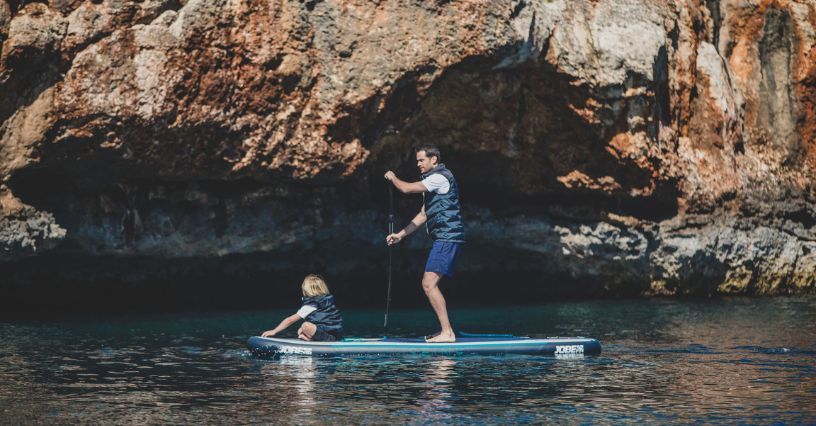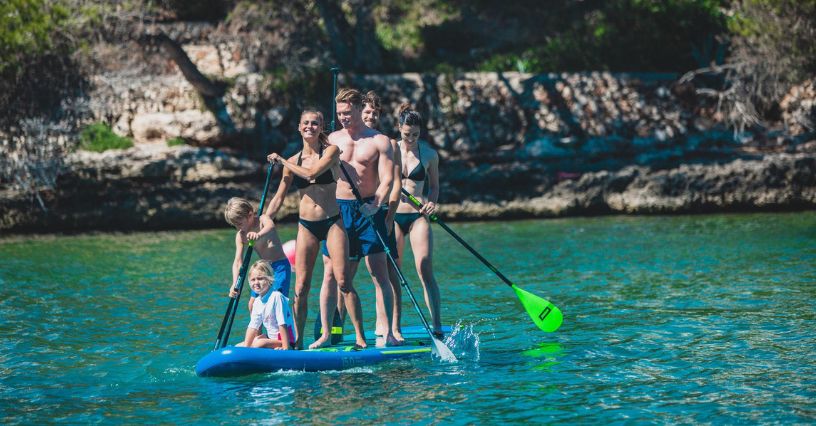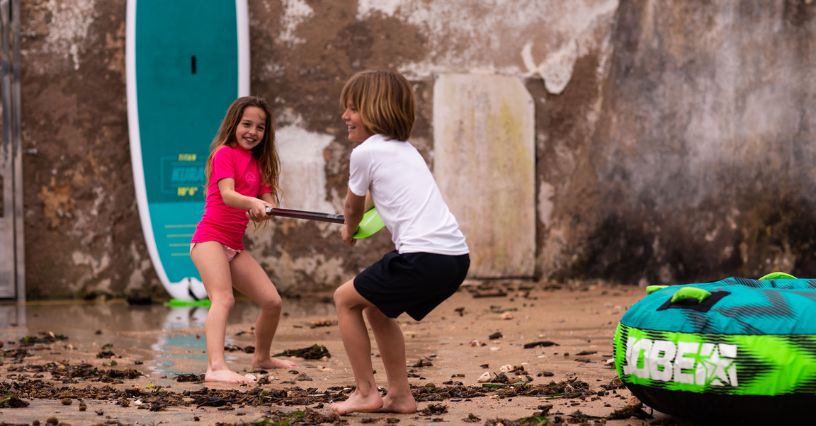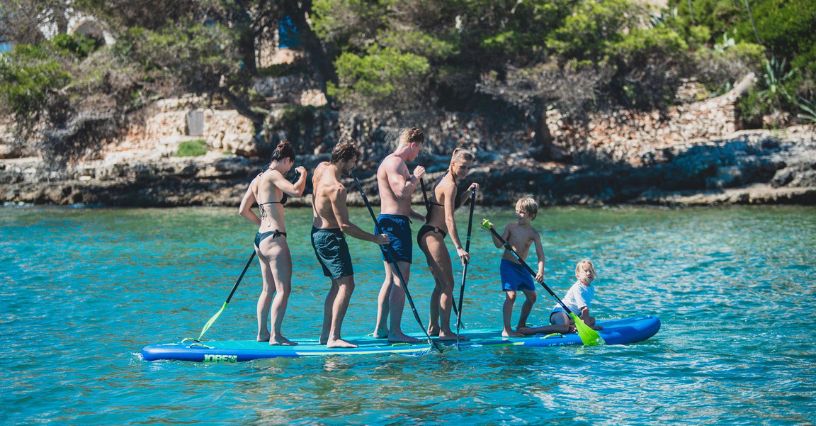Looking for a way to stay active outdoors with your child on sunny days? Swimming on a SUP board could be the perfect solution.
This family-friendly activity not only provides exercise and fun, but also allows you to explore the beauty of nature together. In this guide you will find practical tips to make stand up paddling a safe and successful experience for you and your child.
Find out which paddleboard to swim with your child, how to get them interested in this activity and how to keep them entertained while paddling.
Why is it worth swimming with your child on a SUP?
Stand up paddleboarding, or swimming standing up on a special board with a paddle, is a great activity for the whole family, allowing adults and children to get out of the house and fully enjoy the benefits of sport and contact with nature.
A new hobby can be the impetus for your child to step away from the computer screen, TV or smartphone, get outside and explore the world around them. Another advantage of swimming on the SUP board with the child is the possibility to observe nature from a new perspective.
The little one can admire birds, fish, aquatic vegetation and other elements of nature, encouraging curiosity and respect for the natural environment.
Stand up paddling with your child is a great way to bond and create memories together. Together you can explore new places, discover nature and live unforgettable adventures, thus strengthening the bond between you.

Stand up paddle is also a great all-around workout that allows you to exercise your whole body while increasing your strength and endurance, as well as improving your balance and motor coordination.
Plus, outdoor sports, even recreational ones, reduce stress levels, which in turn is good for your overall mental health, plus you can get a lot of vitamin D.
Standing up on your own or learning to paddleboard is a good way for your child to gain confidence, learn to challenge themselves and be willing to push their own limits.
At what age can children start SUP swimming?
The decision to start SUP swimming with your child depends on several factors, including: the child’s age, swimming skills, experience on the water and individual preferences. Some people try stand-up paddle boarding with a two-year-old, while others wait until their little one is six or until their motor skills are developed enough to paddle independently .
Children can normally start to stand up at the age of 4-6 when they have good enough balance and body control.
However, it’s worth remembering that every child develops at a different rate, so it’s important to be aware of your child’s ability and readiness to try stand up paddling.
Some toddlers may be more interested in water activities than others, so watch to see if your little one expresses a desire to spend time on a paddleboard
Swimming on the SUP board with the child – the most important issues
Before embarking on a SUP adventure, it is important that your child has basic swimming skills – they should be able to stay afloat and move through the water without difficulty.
If your little one is not yet confident in the water and really wants to learn how to stand up paddle, it is worth relying on swimming lessons first .
If your little one has had previous experience with swimming, for example in a pool or lake, they may be more ready to try swimming on a SUP board.
Does your child know how to swim but doesn’t feel comfortable in open water? If you don’t want him to panic if he falls into the water while stand-up paddling, it’s a good idea to organize different types of shallow water games and activities on a lake or river in advance to boost his confidence and prepare him to be on board a SUP.

An extremely important part of paddleboarding with your child is safety. A life jacket is essential when paddleboarding or water sports, both for you (to set a good example) and for your child.
Make sure the model in question has safety certificates that prove it meets certain standards and is the right size for the user.
It is important to analyze with your child the different scenarios that can happen on the water and familiarize your little one with the solutions for specific situations.
Before embarking on a paddleboard adventure, you should also teach him how to fall off and get back on the SUP in safe ways.
What else is needed for paddleboarding with kids?
First, choose the right SUP board for two people or, if your child wants to swim alone, for his abilities and parameters. Before taking a small passenger, always check the size and weight limit of the SUP board .
In general, wider paddleboards are easier to balance (especially if you have a small child sitting in front) and also have a larger load capacity. For starters, choose an Allround inflatable paddle board that is very stable, offers good buoyancy and is easy to handle. If you want to swim with the whole family, a SUP Team board is a good option, accommodating up to 7 people.

Other things that will come in handy for stand-up paddleboard swimming:
- breathable, quick-drying clothing adapted to weather conditions and water temperature;
- adjustable SUP paddle to adapt to the child’s parameters;
- sunscreen (even on cloudy days);
- Sunglasses;
- head covering;
- repair kit (including patches and valve repair tools);
- pump;
- waterproof bag for clothing, other equipment and essentials;
- supplies.
The final set depends on whether the child swims on your board or on his own board, how long and where you plan to swim.
Should your child wear a leash? The decision is yours and depends on you and your little one’s abilities. With a small child, you should ditch the leash – it could get tangled and the small child may not know how to pull the quick release. This might also scare your child and start to panic. If your child knows how to use the leash, it will be safe and useful for him.
Where to start paddling with your child? The best places
Only take your child stand up paddleboarding in calm waters with no strong currents, little or no wind, with enough swimming space to ensure the safety and enjoyment of the whole family. Remember to avoid areas with heavy boat traffic or other objects on the water. For family swimming, the following will work well :
- lake with access to a sandy beach or designated swimming areas,
- a river with weak current and calm water,
- lagoons and bays – especially those protected by the sea. Make sure you choose a suitable location for SUP and that it does not have high waves;
- coasts with shallow, calm waters;
- special SUP areas for families – in some places there are dedicated areas or stand up paddle areas for parents with children. They may have more controlled conditions and access to facilities such as toilets and rest areas.
How to swim with your child on a SUP? Step by step
Always check the weather forecast before going SUP with your child. Be aware that storms and wind can pick up without much warning. Don’t row in an offshore wind. Before you take your child out on the SUP, you need to make sure yourself that you feel completely safe and comfortable paddling alone . Practice balancing, rolling, and getting back in because when you add a kid on board, you’ll have to do all of that and help them get back in, too.
Here are some steps to follow to ensure a high level of safety for you and your child when paddleboarding:
- Start practicing with your child by placing the board on a flat surface, such as grass, and let him practice sitting on it.
- If your child is swimming independently, show him how to hold the paddle correctly and demonstrate the movements he will need to go in different directions.
- Once your toddler has practiced balance on land, it’s time to move on to water. Ideally, have your child stand on the board first in calm, shallow water. Help him by standing next to him and holding the paddleboard. It is a good idea for him to start in the kneeling position to gain confidence in the water. Once he’s comfortable, you can start practicing the transition from standing.
- If you will be swimming together on the same board, place your child right in front of where you usually put your feet and position yourself behind him. Then step onto the board, starting in a kneeling position. Once you’ve determined the best way to balance yourself with the extra weight, you can stand up and ask your child to stand up with you.
- Now it’s time for fun. Although swimming on a SUP with a child can be challenging at first, once you feel comfortable and confident, it will turn into a very rewarding experience for both of you.

How to keep the kids entertained while paddling?
Although swimming on a paddleboard with a parent will initially strongly engage a child, such an activity can become boring just as quickly.
Therefore, it is always a good idea to have in reserve, some ideas to entertain the little one during this time, e.g. :
- tell him to choose an interesting landmark to swim to and see it up close;
- they have tons of interesting things about the body of water you’re sailing in (wildlife, geography, etc.);
- play a game of who can see the most fish in the water.
SUPing with your child has many benefits, both for your child’s development and for family bonding. Not only is it a great way to pass the time, but it’s also a great opportunity to explore nature and enjoy moments on the water together.
It is important to ensure the safety and comfort of the young stand-up paddling enthusiast, to always use life jackets, to respect water safety rules and to adapt your plans to the child’s abilities and preferences.



